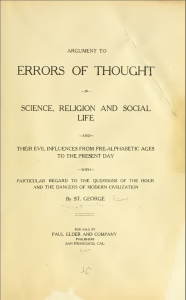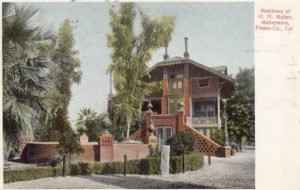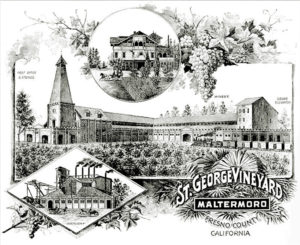
This book is surely the strangest that Paul Elder ever published. It is the antithesis of the attractive, well-printed, easily-read giftable volume that was the Elder specialty. Without a doubt a vanity publication, Errors of Thought in Science, Religion and Social Life (1911) is a long, rambling, incoherent screed on education, science, history, religion, and politics. It’s also poorly typeset, printed on coated stock, and published without a stiff binding. Two states have been seen, the second including an errata page which is just as incomprehensible as the main text. Indeed, it is difficult to understand why Paul Elder was willing to put his name on this bizarre book. And who was the author, identified only as “St. George”?
The story of St. George begins with George Hugo Malter (1852-1927) who immigrated to the United States from Silesia (then in Germany, now part of Poland) in 1866. Malter made his way to California and became a mining engineer, but by 1879 he had abandoned engineering to become a grape grower and winemaker. He proved a successful vintner, and by 1900 Malter owned one of the largest vineyards in California at over 2000 acres. He was a member of the Bohemian Club and the owner of the Emerald, a well-known yacht. The village around his home base in Fresno County was named Maltermoro (today a residential neighborhood of Fresno known as Sunnyside).

The winery’s main brand was called “St. George,” and it specialized in aperitif and dessert wines: Pale Dry Sherry, Dry Sherry, Sherry, and Mellow Sherry; Ruby Port and Tawny Port; Golden Muscat and Muscatel; Madeira and Grenache; Tokay, White Port, and Angelica.
In 1904, Malter married Mabel Pearl Richardson (1882-1967), a San Francisco native. He was 52, she was 22; it was the first marriage for both of them. It is the 29-year-old Mabel who is the author of our book, taking her pseudonym from the winery’s flagship product. In 1914, Mabel wrote another eccentric book, The World Process, this time self-published by the “St. George Publishing Company.”

The draconian restrictions of Prohibition took a huge toll on the St. George winery. By the time George Malter died in 1927, all that was left was a small acreage and the manor house. Their son George Jr. (1906-1979) took the reins of the winery, which limped along until 1942, when it was purchased by the the Eastern wine enterprise L. N. Renault & Sons. Sadly, nothing at all remains of the Maltermoro estate. The site is now the Torrey Ridge apartment and town home complex.
By 1930, the widowed Mabel had managed to marry the wealthy Henry Clifford Fowler Stuart (1864-1952) and was living in the quiet Thousand Oaks neighborhood of Berkeley, California, about a mile north of the University. Henry was a retired railroad executive, mining engineer, real estate investor, and author. He had been director-general of the Guatemala Central Railroad, the U.S. Vice Consul General in Guatemala City 1885-86, and the U.S. Consul General in Guatemala City in 1893. Mabel had found her soulmate, it seems: Henry Stuart was as eccentric as she was. By the early 1940s, he had dropped his given names and was calling himself “Stuart X.” Despite the “X”, Stuart was nationally known and obituaries were printed in newspapers across the country when he died in 1952. His obituary in the Oakland Tribune is worth printing in full:

BERKELEY, May 23. Funeral services will be held tomorrow afternoon for Stuart X, historian, scholar and self-styled philosopher, who died at his home on Wednesday. The funeral is schedule for 1pm at the Chapel of the Flowers at Adeline Street and Ashby Avenue.
Mr. X, born in Brooklyn in 1864 and named Henry Clifford Fowler Stuart, left his own obituary. In it he said he dropped Fowler “as he grew strong enough,” Clifford because no one would use it, and Henry because there were too many “henerys” and annexed an X “to mark his unknownness.”
He prepared the obituary from an entry in the 1942-43 “Who’s Who in California” several years ago and had it printed on a small card. He distributed some of these cards to his friends at that time, but this unusual act, his widow [Mabel] said, caused no alarm because of his originality in other matters.
He described himself as “recorder of his now passing race” and also as a prophet, psychologist (long before the term became respectable), philosopher, philologist, economist, biologist, and individualist.
He stated he left school at 14, “escaping further education,” and “lost 30 years on the other people’s busyness.” He was author of two works, which he lamented, he “had to print and distribute himself.”
A son of California pioneers, he was a land agent for the construction of the Panama Canal and reorganized the bankrupt Salvador Railway Company.
His aspiration, according to his own obituary, was to avoid “in carne re-nating.”
At some point after Stuart X died, Mabel and George Jr. moved to Indiana, where George became a real estate broker. Mabel died in 1967 at the age of 85. In a final bizarre family twist, her son George Jr. died in 1979 when he accidentally shot himself in the leg and bled to death. Both Mabel and George Jr. are buried at Crown Hill Cemetery in Indianapolis.